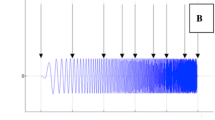Abstract
Transient evoked otoacoustic emission (TEOAE) is being a non-invasive, objective technique and required less time to get administered can be easily used to find out effect of short duration broad band noise (BBN). However one must know the sensitivity of TEOAEs in predicting susceptibility of noise induced hearing loss. Thus the present study has taken up to find out the effect on TEOAE amplitude because of short duration exposure of BBN. Results indicated that there was statistically significant reduction in amplitude of TEOAE at all frequencies except 1 kHz (p < 0.05). It is also observed that the basal region of cochlea is more prone to noise exposure than apical region as revealed in the outcome of the study.

Similar content being viewed by others
References
Kapadia S, Lutman ME (1997) Are normal hearing thresholds a sufficient condition for click-evoked otoacoustic emission? J Acoust Soc Am 101(6):3566–3567
Bonfils P, Piron JP, Uziel A, Pujol R (1988) A correlative study of evoked otoacoustic emission properties and audiometric thresholds. Arch Otorhinolaryngol 245:53–56
Prieve BA, Gorga MP, Schmidt A, Neely S, Peters J, Schultes L, Jesteadt W (1993) Analysis of transient evoked otoacoustic emissions in normal hearing and hearing-impaired ears. J Acoust Soc Am 93:3308–3319
Kemp DT (1978) Stimulated acoustic emissions from the human auditory system. J Acoust Soc Am 64:1386–1391
Rossi G, Solero P, Rolando M, Olina M (1991) Recovery time of the temporary threshold shift for delayed evoked otoacoustic emissions and tone bursts. Otorhinolaryngology 53:15–18
Henderson D, Subramaniam M, Boettener FA (1993) Individual’s susceptibility to noise-induced hearing loss: an old topic revisited. Ear Hear 14:152–168
Cody AR, Johnstone BM (1980) Electrophysiological and morphological correlates in the guinea pig cochlea after exposure to impulsive noise. Scand Audiol Suppl S12:121–127
Henderson D, Spongr V, Subramaniam M, Campo P (1994) Anatomical effects of impact noise. Hear Res 76:101–117
Henderson D, Hamernik RP, Sitler RW (1974) Audiometric and histological correlates of exposure to 1-ms noise impulse in the chinchilla. J Acoust Soc Am 56:1210–1221
Hamernik RP, Henderson D, Salvi R (1980) Contribution of animal studies to our understanding of impulse noise induced hearing loss. Scand Audiol Suppl S12:128–146
Nottet JB, Moulin A, Brossard N, Benoit S, Job A (2006) Otoacoustic emissions and persistent tinnitus after acute acoustic trauma. Laryngoscope 116:970–975
Attias J, Horovitz G, El-Hatib N, Nageris B (2001) Detection and clinical diagnosis of noise-induced hearing loss by otoacoustic emissions. Noise Health 3:19–31
Bohne B, Clark WW (1982) Growth of hearing loss and cochlear lesion with increasing duration of noise exposure. In: Hamernik RP, Henderson D, Salvi RJ (eds) New prospective on noise-induced hearing loss. Raven Press, New York, pp 283–300
American National Standard Institute (1991). Maximum permissible ambient noise for audiometric test rooms. ANSI S3.1-1991. New York
Hirsh IJ, Ward PH (1952) Recovery of auditory threshold after strong stimulation. J Acoust Soc Am 24:95–104
Bohne BA (1976) In: Henderson D (ed) Effects of noise on hearing. Raven Press, New York
Davis H, Morgan CT, Hawkins JE, Galambos R, Smith F (1950) Temporary deafness following exposure to loud tones and noise. Acta Otolaryngol Suppl 88:58–67
Dieroff HG, Schuhmann W, Meibner W, Bartsch R (1991) Erfahrungen uber das verhalten des Hochton-Gehors bei der Auswahl von Arbeitern fur Larmberufe. Laryngo Rhino Otology 70:594–598
Avan P, Loth D, Menguy C, Teyssou M (1991) Frequency dependence of changes in guinea pig cochlear emission after acoustic overstimulation. J Acoust Soc Am 4:91–94
Acknowledgments
The authors would like to thank the Director, AIISH, Mysore, for permitting to carry out this study. The authors also thank the staff of the department of audiology and the participants of the study.
Author information
Authors and Affiliations
Corresponding author
Rights and permissions
About this article
Cite this article
Kumar, P., Kumar, K. & Barman, A. Effect of Short Duration Broad Band Noise on Transient Evoked Otoacoustic Emission Amplitude. Indian J Otolaryngol Head Neck Surg 65, 44–47 (2013). https://doi.org/10.1007/s12070-012-0600-z
Received:
Accepted:
Published:
Issue Date:
DOI: https://doi.org/10.1007/s12070-012-0600-z




